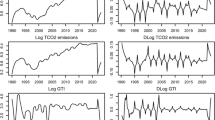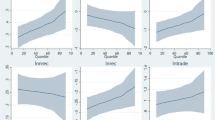Abstract
Climatic events and environmental problems have emerged as worldwide concerns. In the era of global climate change, green innovation is widely believed to ease environmental pollution. Against this backdrop, this study represents the first effort to explore the uneven effects of environmental technology (ENVT) on CO2 emissions controlling economic progress, energy use, openness to trade, and financial development in Saudi Arabia. This study utilizes datasets between 1990 and 2020 from several international organizations and performed the “Nonlinear Autoregressive Distributed Lag (NARDL)” estimation. A set of similar estimation techniques crosschecks the reliability of the NARDL output in addition to the Toda-Yamamoto causality check. The outcomes reveal that due to the low scale of the patents in ENVT relative to the total technologies in Saudi Arabia, the positive components of ENVT remain insignificant to cause environmental pollution, while its negative waves are responsible for a rise in the pollutant emissions both in the long and short terms owing to low level of environmental technology. Economic growth, energy use, and trade volume contribute to pollutant emissions, while financial development remains insignificant to influence the latter. The causality analysis also authenticates the NARDL outcomes and supports the robustness. Therefore, Saudi Arabian policymakers need to focus on enhancing the patent in ENVT and engage in more renewable energy to benefit from them and ensure environmental sustainability.
Similar content being viewed by others
Availability of data and materials
References
Abbass, K., Song, H., Mushtaq, Z., et al. (2022). Does technology innovation matter for environmental pollution? Testing the pollution Halo/haven hypothesis for Asian countries. Environmental Science and Pollution Research, 29, 89753–89771.
Ahmad, M., Khattak, S. I., Khan, A., & Rahman, Z. U. (2020). Zia Ur Rahman Innovation, foreign direct investment, and the energy—pollution-growth nexus in OECD region: A simultaneous equation modeling approach. Environmental and Ecological Statistics. https://doi.org/10.1007/s10651-020-00442-8
Ahmad, M., Zeeshan Khan, Z., Rahman, Z. U., Khattak, S. I., & Khan, Z. U. (2019). Can innovation shocks determine CO2 emissions (CO2e) in the OECD economies? A new perspective. Economics of Innovation and New Technology. https://doi.org/10.1080/10438599.2019.1684643
Ali, N., Phoungthong, K., Techato, K., Ali, W., Abbas, S., Dhanraj, J. A., & Khan, A. (2022). FDI, green innovation and environmental quality nexus: New insights from BRICS economies. Sustainability, 14, 2181. https://doi.org/10.3390/su14042181
Aruga, K. (2019). Investigating the energy-environmental kuznets curve hypothesis for the Asia-Pacific Region. Sustainability, 11, 2395. https://doi.org/10.3390/su11082395
BP Statistical Review of World Energy (2022). https://www.bp.com/en/global/corporate/energy-economics/statistical-review-of-world-energy.html
Chang, K., Liu, L., Luo, D., & Xing, K. (2023). The impact of green technology innovation on carbon dioxide emissions: The role of local environmental regulations. Journal of Environmental Management, 340, 117990.
EIA (2021). US Energy Information Administration, https://www.eia.gov/international/overview/country/SAU
Erdogan, S., Pata, U. K., & Solarin, S. A. (2023). Towards carbon-neutral world: The effect of renewable energy investments and technologies in G7 countries. Renewable and Sustainable Energy Reviews, 186, 113683.
Fortune, G. (2019). The impact of innovation and technology investments on carbon emissions in selected organization for economic co-operation and development countries. Journal of Cleaner Production. https://doi.org/10.1016/j.jclepro.2019.01.235
Hao, Y., & Chen, P. (2023). Do renewable energy consumption and green innovation help to curb CO2 emissions? Evidence from E7 countries. Environmental Science and Pollution Research, 30, 21115–21131. https://doi.org/10.1007/s11356-022-23723-0
Hashmi, R., & Alam, K. (2019). Dynamic relationship among environmental regulation, innovation, CO2 emissions, population, and economic growth in OECD countries: A panel investigation. Journal of Cleaner Production, 231, 1100–1109. https://doi.org/10.1016/j.jclepro.2019.05.325
Islam, M. S. (2021a). Influence of economic growth on environmental pollution in south Asia: A panel cointegration analysis. Asia-Pacific Journal of Regional Science, 5(3), 951–973. https://doi.org/10.1007/s41685-021-00208-5
Islam, M. S. (2021b). Is the trade-led growth hypothesis valid for the kingdom of Saudi Arabia? Evidence from an ARDL approach. Fudan Journal of the Humanities and Social Sciences, 14(3), 445–463.
Islam, M. S. (2022a). Does financial development cause environmental pollution? Empirical Evidence from South Asia. Environmental Science, and Pollution Research, 29(3), 4350–4362. https://doi.org/10.1007/s11356-021-16005-8
Islam, M. S. (2022b). Do personal remittances cause environmental pollution? Evidence from the top eight remittance-receiving countries. Environmental Science and Pollution Research, 29, 35768–35779.
Islam, M. S., & Ali, B. M. A. (2011). Energy consumption and economic development in Bangladesh: An empirical study, Asia-Pacific Journal of Social Science.
Islam, M. S., & Rahaman, S. K. (2023). The asymmetric effect of ICT on CO2 emissions in the context of an EKC framework in GCC countries: The role of energy consumption, energy intensity, trade, and financial development. Environmental Science and Pollution Research. https://doi.org/10.1007/s11356-023-27590-1
Islam, M. S., Rahaman, S. K., Rehman, A., & Khan, I. (2023). ICT’s impact on CO2 emissions in GCC region: The relevance of energy use and financial development. Energy Strategy Reviews, 49, 101147. https://doi.org/10.1016/j.esr.2023.101147
Jalil, A., & Feridun, M. (2011). The impact of growth, energy, and financial development on the environment in China: A cointegration analysis. Energy Economics, 33, 284–291.
Jiang, Q., Rahman, Z. U., Zhang, X., & Islam, M. S. (2022). An assessment of the effect of green innovation, income, and energy use on consumption-based CO2 emissions: Empirical evidence from emerging nations BRICS. Journal of Cleaner Production, 365, 132636.
Khan, A., Muhammad, F., Chenggang, Y., Hussain, J., Bano, S., & Khan, M. A. (2020). The impression of technological innovations and natural resources in energy-growth-environment nexus: A new look into BRICS economies. Science of Total Environment, 727, 138265.
Khattak, S. I., Ahmad, M., Khan, Z. U., & Khan, A. (2020). Exploring the impact of innovation, renewable energy consumption, and income on CO2 emissions: new evidence from the BRICS economies. Environmental Science and Pollution Research, 27(12), 13866–13881.
Lingyan, M., Zhao, Z., Malik, H. A., Razzaq, A., An, H., & Hassan, M. (2021). Asymmetric impact of fiscal decentralization and environmental innovation on carbon emissions: Evidence from highly decentralized countries. Energy & Environment. https://doi.org/10.1177/0958305X211018453
Melcher, D. (2016). How innovation is helping airlines cut carbon emissions. https://www.ge.com/reports/preparing-for-take-off-markets-lift-aviation-emissionssavings.
Mensah, C. N., Long, X., Boamah, K. B., Bediako, I. A., Dauda, L., & Salman, M. (2018). The effect of innovation on CO2 emissions of OCED countries from 1990 to 2014. Environ Science and Pollution Research, 25(29), 29678–29698. https://doi.org/10.1007/s11356-018-2968-0
Narayan, P. (2005). The saving and investment nexus for China: Evidence from cointegration tests. Applied Economics, 37(17), 1979–1990.
Nkoro, E., & Uko, A. K. (2016). Autoregressive distributed lag (ARDL) cointegration technique: Application and interpretation. Journal Statistics and Economic Methods, 5(4), 63–91.
OECD. (2022). Patents in environment-related technologies: Technology indicators. OECD Environment Statistics. https://doi.org/10.1787/e478bcd5-en
Ozokcu, S., & Ozdemir, O. (2017). Economic growth, energy, and environmental Kuznets curve. Renewable Sustainable Energy Review, 72, 639–647.
Pesaran, M. H., Shin, Y., & Smith, R. J. (2001). Bounds testing approaches to the analysis of level relationships. Journal of Applied Econometrics, 16(3), 289–326.
Rahman, M. M., & Alam, K. (2021). Clean energy, population density, urbanization, and environmental pollution nexus: Evidence from Bangladesh. Renewable Energy, 172, 1063–1072.
Shahbaz, M., Hye, Q. M. A., Tiwari, A. K., & Leitão, N. C. (2013). Economic growth, energy consumption, financial development, international trade, and CO2 emissions in Indonesia. Renewable Sustainable Energy Review, 25, 109–121.
Shahbaz, M., Khraief, N., Uddin, G. S., & Ozturk, I. (2014). Environmental Kuznets curve in an open economy: A bounds testing and causality analysis for Tunisia. Renewable Sustainable Energy Review, 34, 325–336.
Santra, S. (2017). The effect of technological innovation on production-based energy and CO2 emission productivity: Evidence from BRICS countries. African Journal of Science Technology Innovation and Development, 9(5), 503–512. https://doi.org/10.1080/20421338.2017.1308069
Shabir, M., Hussain, I., Işık, Ö., Razzaq, K., & Mehroush, I. (2023). The role of innovation in environmental-related technologies and institutional quality to drive environmental sustainability. Frontiers in Environmental Science, 11, 1174827. https://doi.org/10.3389/fenvs.2023.1174827
Shin, Y., Yu, B., & Greenwood, M. (2013). Modeling asymmetric cointegration and dynamic multipliers in a nonlinear ARDL framework. Springer.
Sun, Y., Yesilada, F., Andlib, Z., & Ajaz, T. (2021). The role of eco-innovation and globalization towards carbon neutrality in the USA. Journal of Environmental Management, 299, 113568.
Takalo, S. K., Hossein, S. T., & Zahra, S. P. (2021). Green innovation: A systematic literature review. Journal of Cleaner Production, 279, 122474.
Toda, H. Y., & Yamamoto, T. (1995). Statistical inference in vector autoregressions with possibly integrated processes. Journal of Econometrics, 66(1–2), 225–250.
Umar, M., Ji, X., Kirikkaleli, D., & Xu, Q. (2020). COP21 Roadmap: Do innovation, financial development, and transportation infrastructure matter for environmental sustainability in China? Journal of Environmental Management, 271, 111026.
Umar, M., & Safi, A. (2023). Do green finance and innovation matter for environmental protection? A case of OECD economies. Energy Economics, 119, 106560. https://doi.org/10.1016/j.eneco.2023.106560
Wang, Q., & Zhang, F. (2021). The effects of trade openness on decoupling carbon emissions from economic growth – Evidence from 182 countries. Journal of Cleaner Production, 279, 123838.
World Bank. (2022). The world development indicators, https://databank.worldbank.org/source/world-development-indicators#
Xin, D., Ahmad, M., Hong Lei, H., & Khattak, S. I. (2021). Do innovation in environmental-related technologies asymmetrically affect carbon dioxide emissions in the United States? Technology in Society, 67, 101761.
Zhang, S. (2018). Is trade openness good for the environment in South Korea? The role of non-fossil electricity consumption. Environmental Science and Pollution Research, 25, 9510–9522.
Zhang, Y. J. (2011). The impact of financial development on carbon emissions: An empirical analysis in China. Energy Policy, 39(4), 2197–2203.
Zhang, Y. J., Peng, Y. L., Ma, C. Q., & Shen, B. (2017). Can environmental innovation facilitate carbon emissions reduction? Evidence from China. Energy Policy, 100, 18–28.
Acknowledgements
Not applicable
Funding
There is no funding.
Author information
Authors and Affiliations
Contributions
The author contributes the whole.
Corresponding author
Ethics declarations
Conflict of interests
The author declares that he has no known competing financial interests or personal relationships that could have appeared to influence the work reported in this paper.
Consent to participate
Not applicable.
Ethics approval
Not applicable.
Additional information
Publisher's Note
Springer Nature remains neutral with regard to jurisdictional claims in published maps and institutional affiliations.
Rights and permissions
Springer Nature or its licensor (e.g. a society or other partner) holds exclusive rights to this article under a publishing agreement with the author(s) or other rightsholder(s); author self-archiving of the accepted manuscript version of this article is solely governed by the terms of such publishing agreement and applicable law.
About this article
Cite this article
Islam, M.S. Linking green innovation to environmental quality in Saudi Arabia: an application of the NARDL approach. Environ Dev Sustain (2024). https://doi.org/10.1007/s10668-024-04751-x
Received:
Accepted:
Published:
DOI: https://doi.org/10.1007/s10668-024-04751-x








